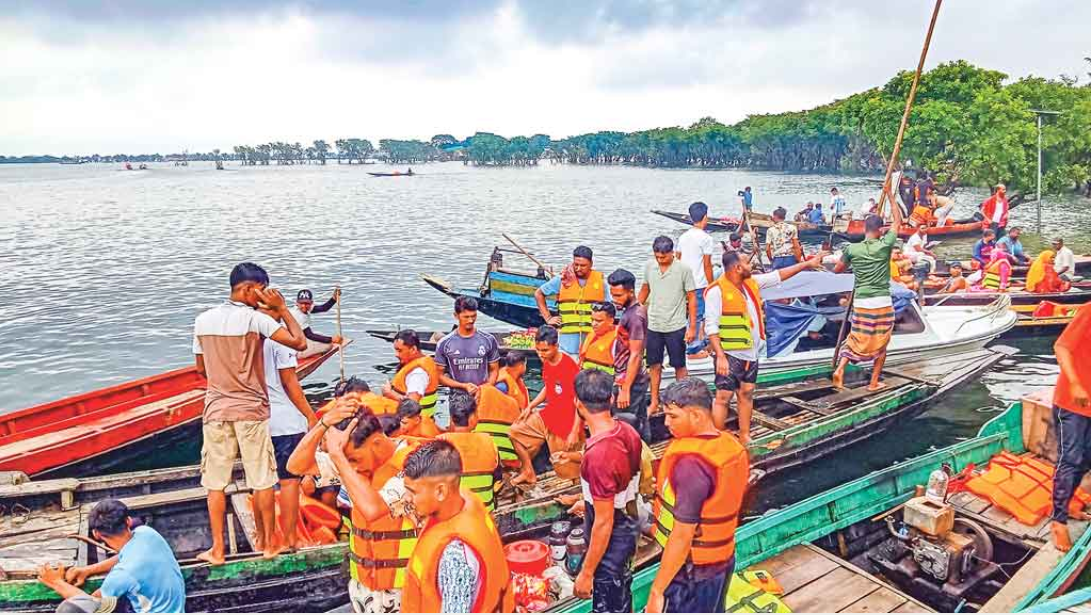Desk Report:
‘Fish, birds, plants, forests—everything was there. Now no native fish species are found in the haor. Earlier, the sound of birds kept me awake at night. Now, even during the day, birds are not seen.’ These are the words of Md. Raja Mia, a haor peddler. Pointing to the wounds from cutting down the trees with his finger from a boat, he said, ‘The source of biodiversity has been killed by cutting down the trees and forests. It seems that there is no owner or employee of this haor.’
Raja Mia was speaking about the Tanguar haor. According to locals, this haor is going through a disaster. Some say that the haor is being damaged due to tourism or houseboats. Others say that the haor is losing its diversity due to the lack of supervision by the administration.
Tanguar haor is spread over 18 mouzas under Dharmapasha and Tahirpur upazilas of Sunamganj district. There are 120 small and big beels in this haor. The area of the entire haor area, including 88 villages, is about 100 square kilometers. Of this, 2,802.36 hectares are wetlands. The livelihood of about 60,000 people is centered on this haor. Recently, when I visited this haor, I saw that the loud noise of engines was coming from all sides, along with the hustle and bustle of tourists. Although there are no houseboats in the trees near the watch tower. However, tourist-laden houseboats are roaming the entire haor, including the nearby Golabari and Jaipur villages.
Although Arafat Hossain Akand, president of the Houseboat Owners Association in Tangua, claims that these boats go to Tekerghat via Matian Haor in Tahirpur, through the Kinchi River in Golabari in Watch Tower. Then they go to Jadukata via the Rakti River and return to Sunamganj via the Anwarpur line. Tanguar Haor is not included in this.
However, a different picture can be seen when visiting the haor. Plastic waste, oil and mobile phones were seen floating in the water. This is polluting the aquatic environment. The owner of a resort on the Tanguar shore said that both small and large engine boats are harmful to the haor. Engine noise, dirt and garbage, excrement are destroying the nature and environment. The role of the administration is also lax. If everything is not brought into order, the situation will get worse.
The overall environment of the Tanguar Haor area has been deteriorating for decades. Considering the ecological heritage and importance, the government has identified this vast haor as an internationally important and critical wetland and listed it as a ‘Ramsar site’ under the Ramsar Convention.
There are no fish and birds in the haor
The haor is known as a ‘paradise’ for winter guest birds not only in Sunamganj, but also in the entire country. About 200 species of guest birds used to arrive here every year. Various endangered species of birds from around the world make temporary homes in this vast haor during the winter. But that picture is no more. Wildlife researcher Simanta Dipu Jalchar highlighted the picture of this year’s bird census and said that the fewest birds have come to Tanguar Haor this year since 1992. Once, about 150,000 birds could be seen during the winter. But this year, only 22,547 birds of 34 species have come.
Tanguar Haor is one of the sources of the country’s fisheries. More than 140 species of freshwater fish used to be found here. However, those fish have disappeared. In this context, Sajal Kanti Sarkar, coordinator of Sunamganj for the protection of the earth, said, ‘With the rotation of the propellers of engine-driven vehicles, petrol, mobile, oil are mixing with the water; which is a threat to the entire biodiversity including fish, birds, plants. The ongoing effort to sustain tourism by damaging the haor will have nothing to do with it.’
In this context, Dr. Mizanur Rahman, a professor in the Department of Forestry and Environmental Sciences at Shahjalal University of Science and Technology, said that waste dumped in water has many effects. This waste reduces the dissolved oxygen levels in the water; which destroys the essential elements for the survival of aquatic animals and plants.
No initiative from the administration
After the abolition of the lease system in the haor, Ansar members were guarding it under the leadership of the executive magistrate. Currently, loose activities are being conducted. From fishing and bird hunting to tourism – everything is going on in the haor. In this situation, Sunamganj Deputy Commissioner Mohammad Ilias Mia said that there is currently no special project for Tangua. The administration is taking care of the haor. There is a plan to take up a special project for the overall development of the haor.
However, Dr. Mizanur Rahman, a professor in the Department of Forestry and Environmental Sciences at Shabiprabir, said that the environment that is needed for biodiversity has been absent in the haor for a long time. He said, the main components of haor biodiversity, such as sedge, sedge, shrubs, and water forests, have completely decreased. It is also necessary to create afforestation in haor to protect a safe environment for birds and wild animals.
Urging to ensure eco-friendly tourism, the professor said, “Everyone wants biodiversity to be protected. Again, we are also enjoying uncontrolled tourism. If we cannot establish a model by determining the tolerable level through research, the situation will worsen.”
In this context, researcher Simanta Dipu said that the goodwill of the district administration and locals is enough to supervise the Ramsar site Tangua. He said, there are opportunities for such tourism in many places in the world. But it is systematic. The government’s tourism, administration, haor master plan – everywhere, instructions are only on paper. There is no systematicity anywhere. Everything needs to be brought within the rules.




